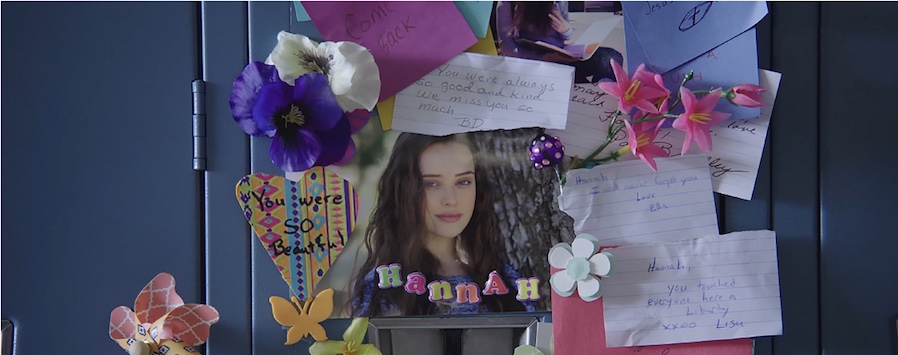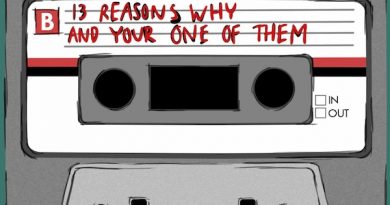‘13 Reasons Why’ leaves viewers with burning questions
13 Reasons Why” took the internet by storm with its release as a Netflix original series on March 31. Based off Jay Asher’s book of the same name, the show left some of us, like me, with a cloud of questions I’m hoping will be answered by a second season. Before the series released, I wrote an article about my expectations for the story and how amazing I believed it would be. I expected the series to stick to the same script as the book with a close, if not perfect, re-enactment of the scenes that I treasure so much from the novel. The series, however, took a completely different route. While the main plotline stayed the same, I could see a lot of disparities between the show and the novel, especially the addition of new scenes and the complete change in timeline. There were some episodes that seemed to drag, and had the usual “thrilling” sound effects and some terrible jokes. It also had dramatic scenes and amazing actors. But overall, the show did a good job attracting audiences and provoking discussion. But the question plaguing my mind is: did it provoke the right discussions?
For those unfamiliar with the show or the book, the story revolves around high school student Clay Jensen as he mourns Hannah Baker, a classmate who had recently committed suicide. Hannah sent 13 tapes containing the 13 events that led her to her death to the people that caused them. Each person who gets the tapes is supposed to listen to them and pass them onto the next person on the list. The story focuses on Clay and his actions as he listens to the tapes.
Many people have spoken out about the show being a great new way to look at the gruesome topic of suicide, which is definitely not easy to speak about. However, the series didn’t do the best job at it. Molly Kate Cline stated in one of her Teen Vogue articles that she “Immediately saw some red flags.” She goes on to show that the characters resorted to bullying, missing school and many other unhealthy behaviors rather than reaching out to elders to receive help for their emotions. Cline later states that, “13 Reasons Why is increasing the stigma around mental illness by not directly addressing it and dancing around it.” She points out that the words “mental illness” were never even used during the show.
Of course, Cline isn’t the only person who saw the “red flags.” Many articles about the series address the fact that they’re glad it’s taking a step toward addressing this topic, even though it could have done a better job. In an article on Refinery29, Anne Cohen compares the series to a “how-to guide to suicide.” On the other hand, writer Kevin Schwaller disagrees. He sees these issues as needing to be addressed because “Rape happens. Suicide happens.” Dealing with these topics is hard and shows like “13 Reasons Why” are useful tools because, “sometimes people don’t fully understand things until they see visuals.”
Other than these writers and journalists, many people on social media have also opened up about their views on the series. One Tumblr states that “the show has value,” but it “deserves advocates as much as it deserves critics.” I find myself agreeing with them. Yes, the show definitely had some questionable scenes, but at the same time, it deserves recognition for its attempt.
An aspect of the show that should provoke discussion was Alex’s final scene. Audiences see that he is in a critical condition after attempting suicide. This is important because we are shown clear signs of depression in Alex throughout the series, yet most of us fail to notice them. We’re all so caught up in Hannah’s story that we forget to watch out for other characters. This is a good way to show audiences that we might miss what’s happening right in front of our own faces — despite knowing what to look for.
As an avid fan of the novel, I found myself disappointed with certain aspects of the series. I loved watching the story play out on-screen, but found issues in the portrayal. The first problem had to do with Clay in the final episode as he sent Hannah’s tapes to a teacher who was involved with an added 14th tape — which did not happen in the book. This last tape included a confession from the man who sexually assaulted Hannah and one of her friends. This is problematic because Jessica, the surviving victim of the assault, was not ready for it to go public — which she made clear in a previous conversation with Clay. He completely ignored her wishes and gave the tapes to Mr. Porter anyway. This last action also seemed to imply Clay believed it was the assault that pushed Hannah over the edge and nothing else. However, the whole moral of the book is to show that what drives someone to suicide is complicated. The addition to Hannah’s final words in the show undermined a critical deeper meaning that was presented in the book. For Hannah, it was the combination of every reason she talks about in her tapes — not just the assault — that drove her to suicide. She was depressed to the extent of suicidal thoughts even before she was assaulted. In the novel, it was almost like she was looking for a final straw to push her over the edge and the assault seemed to be it, rather than the assault being the sole cause.
The average person can watch the show, then sit down and reflect on their life, which is great. However, if the goal of the show is to reach out to those suffering from depression and suicidal thoughts themselves, wouldn’t depicting these struggles in such a graphic manner harm these individuals rather than help them? By showing what Hannah went through with her suicidal thoughts, isn’t the show simply saying it is an option? Another issue with the extremely graphic representation is how people might take the idea literally and try to do the same themselves. An article on PsychologyToday states that the media should avoid detailed descriptions of suicide including method and location. Yet detailed description is exactly what this series did. They showed Hannah’s suicide up close and personal, down to her very last minutes, even after telling a journalist at Bustle that executive producers “consulted with several mental health professionals.” Of course, the intent of the producers was not to ignore the advice they received from professionals. But there are real guidelines when portraying suicide in the media and show seemed to have ignored them.
In the end, there were some positive and negative parts of the series. Everyone involved only tried to do good by getting people to start speaking about suicide, even if they didn’t hit the bullseye in the end. Netflix opened a lot of doors for season two, leaving us craving answers. This was just a step, and it could have been done better, but at least it was a step! Despite its issues, “13 Reasons Why” is an extremely emotional series that will grip you by your heart strings.







